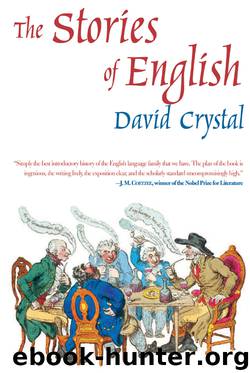The Stories of English by David Crystal

Author:David Crystal [CRYSTAL, DAVID]
Language: eng
Format: epub
Tags: LAN009010, LAN024000, HIS015000
ISBN: 9781468306170
Publisher: Overlook
Published: 2012-08-19T16:00:00+00:00
Some further examples are given on p. 326. It remains a lexicological puzzle why some words were accepted and some rejected. We do not know how to account for the linguistic ‘survival of the fittest’. Both impede and expede were introduced during the period, as well as disabuse and disadorn, but in each of these pairs the first item stayed in the language and the second did not. In some instances, the prior existence of another word may have motivated the rejection – the presence of visible, for example, would have made it more difficult to promote aspectable – but we know from earlier periods of English that this is not an obligatory state of affairs, for many doublets arrived in English during the Middle Ages and both survived, developing different senses or nuances (p. 151). Some neologisms doubtless became popular because of their use in an influential text or word list. Some (such as those associated with a particular religious view, p. 240) might have conveyed connotations which prevented their being widely taken up. In literary contexts, a coinage might have been made solely to meet the needs of the metre, as in the Shakespearean use of cursorary (‘cursory’, p. 364). In many cases, the adaptation of a previously existing word (i.e., giving it a new sense) would have seemed a more natural solution. There are several other possible explanations. An important step will be the construction of a historical and stylistically aware thesaurus to give us a first sense of the ‘competition’ which exists between words during a time of rapid lexical growth in a language; and such projects are still in their early stages.5 The understanding of communal lexical decision-making has hardly begun.
As the century progressed, more balanced views began to appear, along with defences of the increasingly mixed character of the language. The matter was put into its historical perspective by William Harrison, whose Description of Britaine (1587) was printed as prefatory material in the second edition of Holinshed’s Chronicles, and thus achieved a wide readership (including Shakespeare). In Chapter 6, ‘Of the languages spoken in this Iland’, he sums up the contemporary situation. He first draws attention to how English had grown in estimation since the days when the ‘French rascall’ had failed in his effort to get English exiled:
for in the time of king Edward the first, to wit, toward the latter end of his reigne, the French it selfe ceased to be spoken generallie, but most of all and by law in the midst of Edward the third, and then began the English to recouer and to grow in more estimation than before; notwithstanding that mong our artificers, the most part of their implements, tooles and words of art reteine still their French denominations euen to these our daies, as the language it selfe is vsed likewise in sundrie courts, bookes of record, and matters of law; whereof here is no place to make any particular rehearsall.
Download
This site does not store any files on its server. We only index and link to content provided by other sites. Please contact the content providers to delete copyright contents if any and email us, we'll remove relevant links or contents immediately.
| General | Channel Islands |
| England | Northern Ireland |
| Scotland | Wales |
Room 212 by Kate Stewart(4097)
The Crown by Robert Lacey(4097)
Endurance: Shackleton's Incredible Voyage by Alfred Lansing(3831)
The Iron Duke by The Iron Duke(3634)
The Rape of Nanking by Iris Chang(3505)
Killing England by Bill O'Reilly(3447)
Joan of Arc by Mary Gordon(3252)
Say Nothing by Patrick Radden Keefe(3053)
I'll Give You the Sun by Jandy Nelson(2836)
Hitler's Monsters by Eric Kurlander(2727)
Shadow of Night by Deborah Harkness(2707)
Margaret Thatcher: The Autobiography by Thatcher Margaret(2680)
Mary, Queen of Scots, and the Murder of Lord Darnley by Alison Weir(2673)
Darkest Hour by Anthony McCarten(2643)
Blood and Sand by Alex Von Tunzelmann(2605)
Red Famine: Stalin's War on Ukraine by Anne Applebaum(2458)
Eleanor & Park by Rainbow Rowell(2385)
The One Memory of Flora Banks by Emily Barr(2343)
Book of Life by Deborah Harkness(2257)
